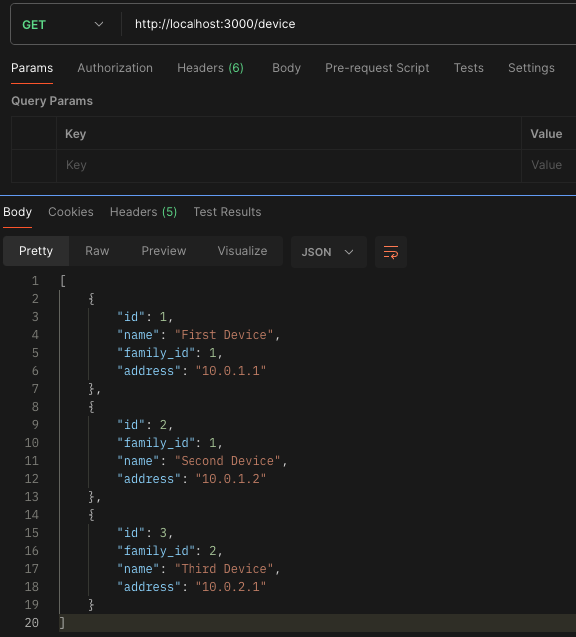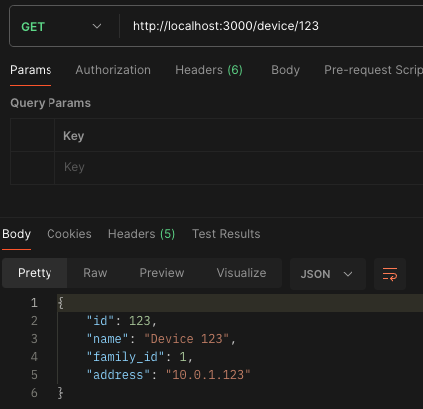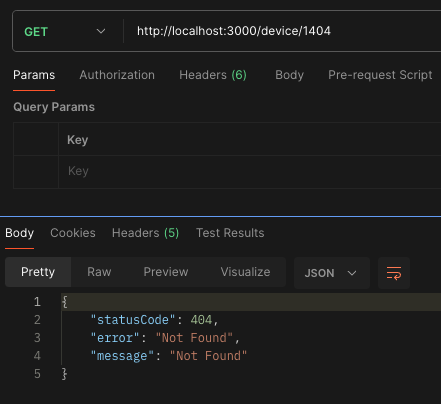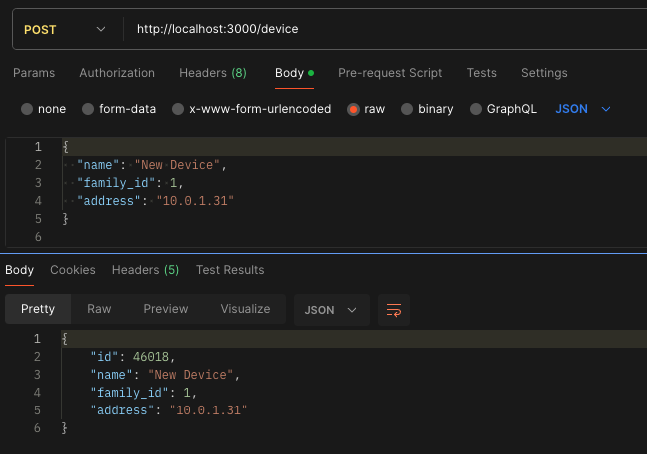dev-resources.site
for different kinds of informations.
Fastify Meets WireMock: External Service Mocking
WireMock Wonders: Boosting Fastify Testability
This article reveals how to integrate WireMock into Fastify with ease, enabling developers to effortlessly generate mock responses for external services. Join us as we explore the straightforward process of seamlessly integrating and optimizing Fastify applications using WireMock for enhanced testing capabilities.
A Use Case: Integration with an External Service
In this scenario, we'll illustrate the integration with an external service. The service in focus simulates calls to a generic "devices" management system. Our objective is to retrieve the list of devices, read a device by its ID, and create a new one. Let's delve into the practical application of WireMock within Fastify for this specific use case.
Fastify App
We kick off by creating a simple Fastify application in TypeScript, utilizing the fastify-cli.
src/app.ts
export interface AppOptions extends FastifyServerOptions, Partial<AutoloadPluginOptions> {
}
const options: AppOptions = {
}
const FastifyEnvOpts = {
dotenv: true,
schema: {
type: 'object',
required: ['DEVICE_SERVER_URL'],
properties: {
DEVICE_SERVER_URL: {
type: 'string'
}
}
}
}
const app: FastifyPluginAsync<AppOptions> = async (
fastify,
opts
): Promise<void> => {
void fastify.register(FastifyEnv, FastifyEnvOpts)
void fastify.register(AutoLoad, {
dir: join(__dirname, 'plugins'),
options: opts
})
void fastify.register(AutoLoad, {
dir: join(__dirname, 'routes'),
options: opts
})
}
export default app
export { app, options }
Building a Service to Interact with the External System
Now, let's craft a service that interacts with the external system. In this section, we'll guide you through the process of creating a Fastify service that communicates with the simulated external 'devices' management system. This hands-on approach will showcase the seamless integration of our Fastify application with WireMock for effective testing and interaction with external services.
src/plugins/deviceService.ts
// ... imports
export default fp(async (fastify, opts) => {
const SERVER_BASE_URL = `${fastify.config.DEVICE_SERVER_URL}/api/v1/device`
const deviceService = {
getDevices: async (): Promise<Device[]> => {
const response = await fetch(SERVER_BASE_URL)
return await response.json() as Device[]
},
getDeviceById: async (id: string): Promise<Device | null> => {
const response = await fetch(`${SERVER_BASE_URL}/${id}`)
if (response.status === 404) {
return null
}
return await response.json() as Device
},
createDevice: async (device: DeviceRequest): Promise<Device> => {
const response = await fetch(SERVER_BASE_URL, {
method: 'POST',
body: JSON.stringify(device),
headers: {
'Content-Type': 'application/json'
}
})
return await (await response.json() as Promise<Device>)
}
}
fastify.decorate('deviceService', deviceService)
})
src/model/device.ts
export interface DeviceRequest {
name: string
type: string
address: string
}
export type Device = DeviceRequest & {
id: string
}
Using the deviceService in the Controller
src/routes/device/index.ts
// ...imports
const route: FastifyPluginAsync = async (fastify, opts): Promise<void> => {
fastify.get<{ Reply: Device[] }>('/', async function (request, reply) {
return await fastify.deviceService.getDevices()
})
fastify.get<{ Params: GetDeviceByIdParams, Reply: Device | GetDeviceByIdError }>('/:id', async function (request, reply) {
const result = await fastify.deviceService.getDeviceById(request.params.id)
if (result === null) {
return await reply.notFound()
}
return result
})
fastify.post<{ Body: DeviceRequest, Reply: Device }>('/', async function (request, reply) {
const result = await fastify.deviceService.createDevice(request.body)
return reply.code(201).send(result)
})
}
export default route
Setting Up WireMock
Let's dive into configuring WireMock for our project. We'll employ Docker to define the WireMock service, simplifying the setup process. By using containers, we ensure a convenient and reproducible environment for running WireMock alongside our Fastify application.
docker-compose.yml
version: '3.9'
services:
wiremock:
image: wiremock/wiremock:3.3.1
restart: always
ports:
- '8080:8080'
volumes:
- ./wiremock_data:/home/wiremock
entrypoint: ["/docker-entrypoint.sh", "--global-response-templating", "--verbose"]
wiremock_data/mappings/get_devices.json
{
"request" : {
"url" : "/api/v1/device",
"method" : "GET"
},
"response" : {
"status" : 200,
"bodyFileName" : "get_devices_response.json",
"headers" : {
"Content-Type" : "application/json"
}
}
}
wiremock_data/__files/get_devices_response.json
[
{
"id": 1,
"name": "First Device",
"family_id": 1,
"address": "10.0.1.1"
},
...
]
wiremock_data/mappings/get_device_by_id.json
{
"request" : {
"urlPattern": "^/api/v1/device/\\d*",
"method" : "GET"
},
"response" : {
"status" : 200,
"bodyFileName" : "get_device_by_id_response.json",
"headers" : {
"Content-Type" : "application/json"
}
}
}
wiremock_data/__files/get_device_by_id_response.json
This template utilizes dynamic templating, generating a response tailored to the input parameters. In this instance, the 'id' parameter influences the response, showcasing the flexibility and adaptability achieved through WireMock's templating capabilities.
{
"id": {{ request.pathSegments.[3] }},
"name": "Device {{ request.pathSegments.[3] }}",
"family_id": 1,
"address": "10.0.1.{{ request.pathSegments.[3] }}"
}
wiremock_data/mappings/get_device_by_id_404.json
{
"request" : {
"urlPattern": "^/api/v1/device/\\d*404$",
"method" : "GET"
},
"response" : {
"status" : 404,
"body" : ""
}
}
The setup is designed to manage scenarios where the 'id' ends with '404'. When a request matches the defined URL pattern and method (GET), WireMock responds with a 404 status code, providing a straightforward mechanism to simulate and test error conditions for our Fastify application.
wiremock_data/mappings/create_device.json
{
"request" : {
"url" : "/api/v1/device",
"method" : "POST",
"headers" : {
"Content-Type": {
"equalTo": "application/json"
}
},
"bodyPatterns": [
{
"matchesJsonPath": "$.name"
},
{
"matchesJsonPath": "$.family_id"
},
{
"matchesJsonPath": "$.address"
}
]
},
"response" : {
"status" : 201,
"bodyFileName" : "create_device_response.json",
"headers" : {
"Content-Type" : "application/json"
}
}
}
wiremock_data/__files/create_device_response.json
{
"id": {{randomValue type='NUMERIC' length=5}},
"name": "{{jsonPath request.body '$.name'}}",
"family_id": {{jsonPath request.body '$.family_id'}},
"address": "{{jsonPath request.body '$.address'}}"
}
We leverage dynamic templating to generate varied responses. The 'id' field is populated with a random numeric value of length 5. The 'name', 'family_id', and 'address' fields are populated based on the corresponding values present in the incoming request body. This dynamic approach allows us to simulate diverse scenarios and handle input data flexibly within our WireMock setup.
Testing
During the testing phase, we don't need to perform service-level mocks since we are directing our requests to the WireMock URL. By utilizing WireMock as the target URL, we seamlessly integrate our Fastify application with the WireMock service, allowing for realistic simulations and comprehensive testing scenarios without the need for extensive service-level mocking.
test/routes/device.test.ts
...
test('get device by id', async (t) => {
const app = await build(t)
const res = await app.inject({
url: '/device/123'
})
const payload = JSON.parse(res.payload)
assert.equal(res.statusCode, 200)
assert.deepStrictEqual(payload, { id: 123, name: 'Device 123', family_id: 1, address: '10.0.1.123' })
})
test('get device by id - 404', async (t) => {
const app = await build(t)
const res = await app.inject({
url: '/device/1404'
})
const payload = JSON.parse(res.payload)
assert.equal(res.statusCode, 404)
assert.deepStrictEqual(payload, { "statusCode": 404, "error": "Not Found", "message": "Not Found" })
})
...
Conclusions
WireMock provides a comprehensive solution for building a test suite towards external services, eliminating the need for patching services at the application level. This approach enables us to conduct real tests, fostering a robust testing environment and ensuring the reliability and effectiveness of our Fastify application in interacting with external services.
The project code is in this GitHub repository: fastify-wiremock-example.
Featured ones:



